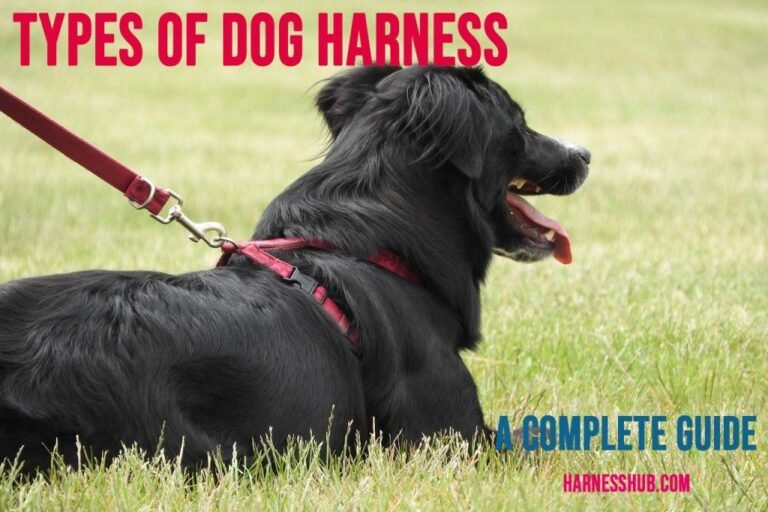
I know, there are many pet parents and dog lovers in the world that want to know about dog harnesses and the types of harnesses available. Therefore, this post was created as a guide that will discuss the different types of dog harnesses and their differences.
Understandably there are so many stylish options today when it comes to harnesses for your pet — safety and comfort for your adorable friend doesn’t necessarily have to be boring or bland.
Undeniably one of the best ways to ensure you have a pleasant time walking and handling your dog is to opt for a harness. By and large the comfort for your pet and the control provided to its owner are two of the main reason so many pet parents have switched to the harness vs. the regular dog collar.
Types of Dog Harnesses
Comparatively speaking, the different types of dog harnesses provide you with different aspects of control (over) and handling (of) your pet. Generally, they all seek to provide comfort and reduce pressure, especially around your pet’s throat and neck area. Understandably this is something very import to all pet owners and pet parents. Not to mention dog harnesses come with a variety of options and in numerous styles.
Regardless of your final choice you want to ensure you choose an option that is safe and durable. Even if you choose one of the more cost-effective options you want to make sure you lean towards an option that provides utility over style. The different types of harnesses are discussed below, which should assist you with choosing an option when in the market to purchase one for your pet.
Front-Clip Type of Dog Harnesses
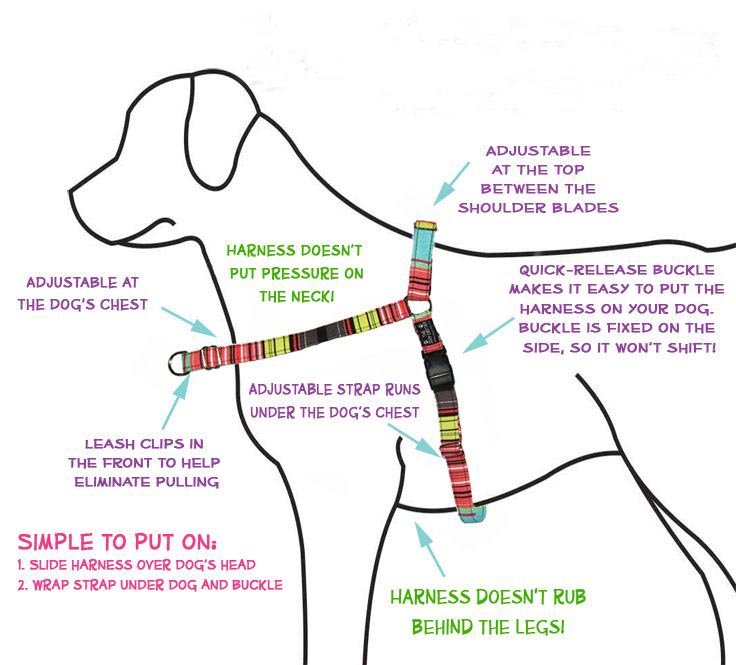
Front-clip harnesses provide a unique advantage when your dog’s a puller. The leash is attached just below the front neck of your dog, which makes it harder for your pet to pull you in its direction. This is a primary reason why this type of harness is used by professional dog trainers. You can use this dog harness to stop your dog’s pulling behavior.
However, since the leash attaches in the front your dog’s feet can get tangled if the owner does not pay careful attention to keep the slack removed. As a matter of fact this can be very uncomfortable to the dog, but the issue here has more to do with attentiveness of the its owner.
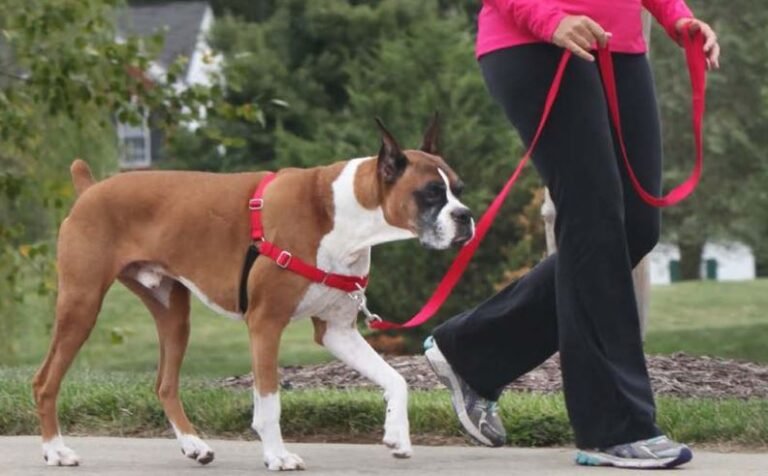
Pros:
- Harder For Your Pet to Pull You.
- You Gain More Control of Your Dog's Movement.
- It Can Transform Your Dog's Pulling Behavior.
Cons:
- Leash Could Get Tangled In Dog's Feet If Handled Loosely.
- The Dog Could Gain Control If the Leash Is Attached Loosely or Handled Loosely.
Back-Clip Harnesses
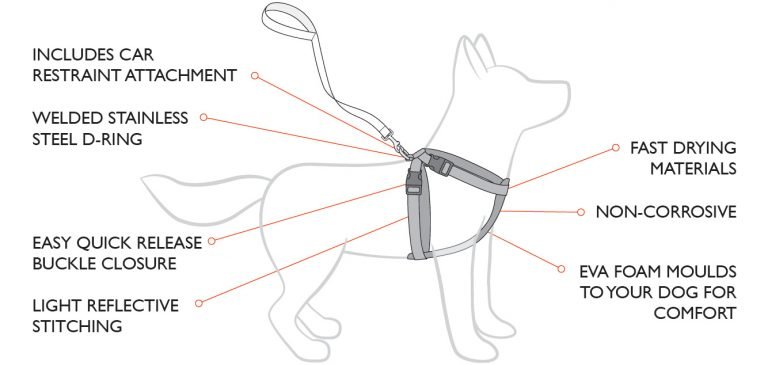
In contrast to the front-clip harness, the back-clip harness is attached firmly at the dog’s back. Generally this type of dog harness is perhaps the most common type for dog owners. Furthermore it is very convenient for the owners and is very comfortable for the dog as well.
For one thing the attachment is designed in such a way that it stays clear from the dog’s trachea, which as you can infer is very important — especially for smaller dogs. However, the back-clip does not provide you with as much control as the front-clip harness.
As a result if your dog has a habit of constantly pulling or a little on the aggressive side when out, then perhaps you should opt for a different type of dog harness than the back-clip.
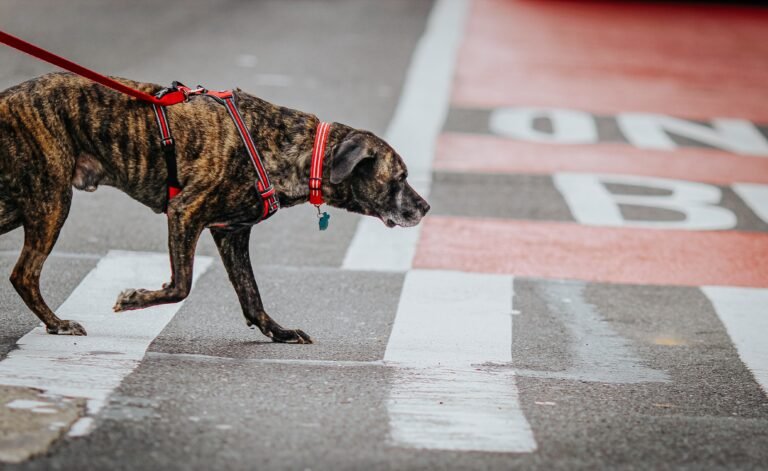
Pros:
- Leash Will Not Tangle In Dog's Feet.
- Attachment Area Is Positioned Away From the Throat and Neck Area.
- Easy To Keep Slack Out Of Leash.
Cons:
- You May Not Be Able To Steer Your Dog In a Particular Direction.
- Does Not Really Assist With Changing Your Dog's Pulling Behavior Via Training.
Dual-Clip Type of Dog Harnesses
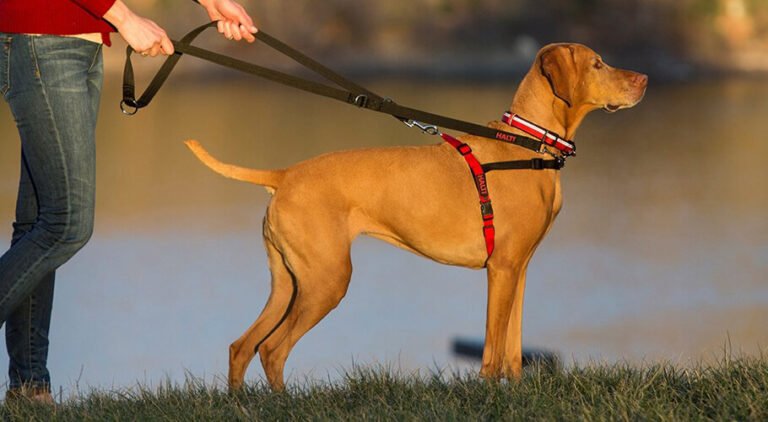
As the name suggests, the dual-clip harness gives you the option to attach your leash both at the front or at the back. Basically if you have a dual clip leash you can attach it to both the front and back simultaneously.
Having this harness provides you with options while you’re walking your dog. For this purpose if it starts pulling you can go for the front-clip attachment or for a more relaxed setting you can attach your leash at the back.
Moreover, when it comes to the different types of dog harnesses the dual-clip comes in the category of higher-cost options. Therefore it is recommended that you opt for this harness only if you desire to have the options on how to control your dog during walks.
Pros:
- Combination Of Front and Back Clips Provide the Extra Control Dog Owners Look For.
- Excellent Pulling Control.
Cons:
- More Expensive Option.
Head Halter

When discussing dog harnesses types, the head halter is the option that gives the owner muzzle control. If you think your dog is slightly more reactive when on a leash or the owner is training a more aggressive dog in public areas, then it’s good to go for the head halter. Overall this harness looks like a muzzle with a strap around the dog’s mouth.
Opposed to what it may look like, it is not painful for dogs at all. Despite the look of the harness they can actually open their mouths easily. Basically the head halters go around the neck and across the snout of your pet.
When your dog pulls on the leash the halter will force the dog’s nose downwards and towards you. This gives the owner ultimate control of the dog’s head and front-shoulder areas.
More About Head Halters...
At first, your dog may feel uncomfortable with the head halter and may try to get rid of it using its paws or rubbing the mouth against the floor. What you’ll need to do is use some positive reinforcement to forcefully impose this halter harness. Obviously you will only have to do this until the dog is comfortable and understands its limits when wearing the harness.
Although there is something you may want to consider when using this harness. In the event that you pull on the leash abruptly it may cause an injury or irritate your pet’s throat.
Therefore, if you’re planning on using a head halter for your dog make sure to use it with a retractable leash. Any sudden stops or jerks of the leash could result in an injury, but with the retractable leash you remove that possibility.
Pros:
- You Gain Control Over Dog's Pulling Habits and Counter It Effectively.
- Great For Larger Breeds That May Be More Difficult To Control.
- Counters Dog's Pulling Without Causing Injury or Pain.
- Provides Best Control Of Aggressive Dogs In Crowded Areas.
Cons:
- Requires Adjustment Time For Dogs In the Beginning.
- You May Have To Purchase an Additional Leash - Retractable Leashes Are Suggested.
- The Appearance Of Head Halters Are Not Aesthetically Appealing.
Step-In Types of Dog Harnesses
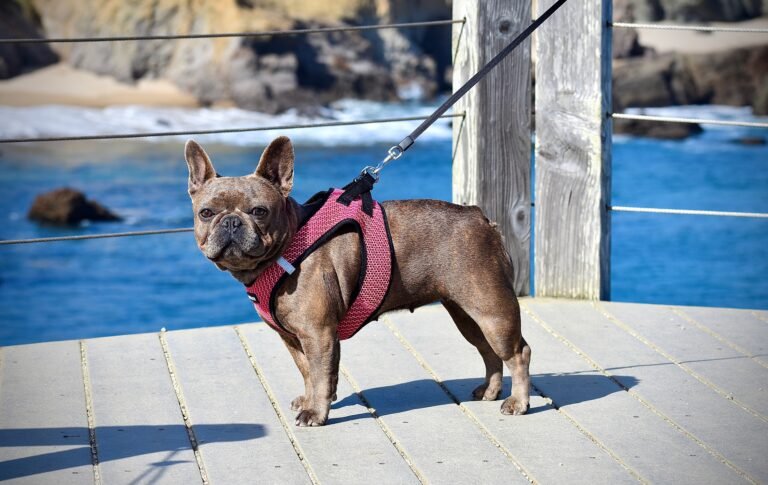
Lastly, on the list of different types of dog harnesses comes the Step-In. Basically this harness wraps around the front legs of your pet. You can spread out the harness on the ground and allow your dog to step over it and put his legs through the openings.
When the front legs are in just pull the harness up and clip it at the back of your dog. Regardless of your dog’s size this harness is perfect for an obedient dog.
Most back-clip and front-clip harnesses are step-in harnesses, but not always. It is important to size the harness correctly for your pet. Many have adjustable straps that will facilitate use for most average-sized dogs. Nevertheless be aware of sizing options if your pooch is on the smaller side or one of the larger breeds.
Pros:
- Easy To Put On
- Adjustable Sizing
- Attachment Locations In Both Front and Back
Cons:
- May Not Be the Best Option For Excited or Reactive Dogs
Conclusion
As can be seen there are a variety of different types of dog harnesses available in the market. Evidently there’s no one perfect harness for any dog, but based on their behavior and training you can certainly find the most effective harness.
For smaller dogs that don’t put too much pressure on the leash, the back-clip harness would be the way to go. However, perhaps you should opt for the front-clip harnesses for energetic dogs that like to take charge when out for a walk.
Please Share this article with your friends and other pet parents.


